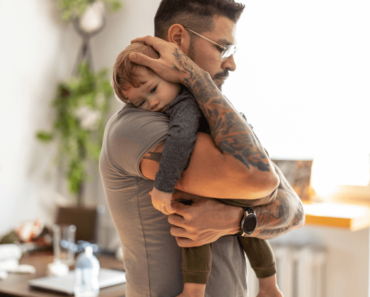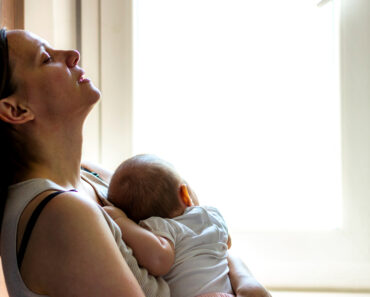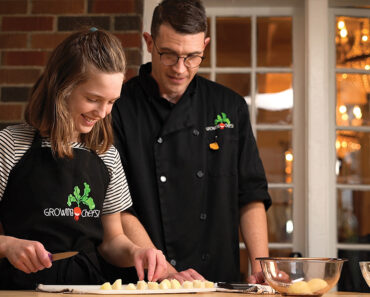From wriggling up the door frame to escaping their cribs, this anxiety-inducing phase is completely normal. Here’s how to safely encourage your little climber.
At age two, Lee-Anne Maier’s son, Theo, was still in diapers, but he could climb to the top of the 12-foot net climber at the playground down the street. Maier quickly got used to all the concerned looks from other parents at the park. “He was such a small kid that he looked like a baby climbing that thing! But I would just say, ‘Hey, good job!’ because I was so certain he could do it.”
His other favourite trick was to grab the frame of a doorway (one hand on each side), wriggle himself up until he was dangling about six inches off the floor, and hang there like a monkey, clamped on for as long as he could.
Even kids who aren’t climbing the walls of your home, like Theo, usually go through a phase around age one or two where they want to climb everything, says Mathilde Duflos, a developmental psychologist in BC.
My own daughter wasn’t a big playground climber, but she quickly learned to escape the crib, thrilled in climbing up the chairs to stand right on top of the dining room table, and she wanted to play “climb Mama”—where she would hold my hands and scale me—as many times as I would let her.
“There is a huge component of personality to it,” says Kaitlin Rickerd, a paediatric physical therapist in New York and the creator of Milestones and Motherhood, a popular Instagram account about children’s physical development. “But climbing is hugely beneficial.”
Why toddlers climb
Duflos explains that climbing is “a new way for kids to explore the world, and explore their body.” It uses new muscles in a toddler’s shoulders and hips, and they use their core to balance. With every move, their brain has to figure out where each hand and foot should go, and they need to use their coordination to put them in the right spot. As they move the left side of their body, the right part of their brain lights up with activity; as they move the right side, the left side lights up—and using both sides at once to climb helps forge connections between the two. Since all four limbs are touching something at the same time, they’re also getting lots of feedback about where their body is in space. This is called proprioception or kinaesthesia, and some people call it the “sixth sense,” says Duflos.
These systems are growing exponentially during the first three years of life. This is why working all of them by climbing is a great way to help your child’s brain grow, says Rickerd. There’s also the brain work that comes with such a complex task—assessing risk and executing a multi-step plan while staying focused.
Is my kid normal?
If your kid can’t climb by the time they’re walking, Duflos says, that’s something you should talk to your doctor about. Another potential red flag is the frequency of injuries. While many toddlers are daredevils and minor injuries are common, some kids don’t seem to learn from their mistakes—and that can be a clue that something might be up. “Some kids continue to climb and take high risks, even after learning that what they’re doing is dangerous. That can be the first sign of ADHD,” says Duflos. (People with ADHD tend to take more risks—and in a toddler, that might look like more dangerous play. Most kids with ADHD aren’t diagnosed until later into childhood, but if you’re concerned, talk to your doc.)
How to keep your climber safe
Climbing is important—but it’s also stressful when you turn around and your kid has scaled the baby gate and is scampering up the stairs solo. First, limit risk by making sure your TV and furniture, like dressers, are properly anchored to the walls, then try to find some space where your kid can safely climb and learn. It doesn’t have to be elaborate. Instead of telling her toddler son, “No, get down,” all the time, Erin Criger, a mom in Toronto, had “stair time” scheduled into her days, where she let him climb up and down the front steps of their house as many times as he wanted. “He loved it,” she says.
For something a bit more complex, you can use couch cushions, throw pillows or a crib mattress to build a makeshift obstacle course. You could lean an ironing board against the couch for them to crawl or climb up, says Rickerd. “Bringing the climbing activities down closer to the floor, where there’s less risk, can make it a lot easier to find that balance between ensuring they’re safe and letting them explore.”
If you have the space and the resources, a Pikler triangle or a foam kids couch can be a great designated climbing area. Rickerd prefers a foam couch, since many Piklers are tall and need active supervision.
Step back and stand down
Take a deep breath and try not to step in too often. “Climbing is naturally a source of stress for parents because it’s risky,” says Duflos. “But if you are overprotective, they never learn what they’re able to do, and what’s dangerous—and they’re actually more likely to get severe injuries later.”
Maier adopted an “if he got there himself, he can get down himself” philosophy when Theo was young. “I had to learn not to be scared,” she says. Instead of shouting warnings, she repeated a phrase to him about safety: “A place for your hands, a place for your feet.” Soon, he started repeating it to himself as well.
As they get older, most kids tend to continue to climb, but they grow less focused on the task and more focused on socializing: climbing just becomes part of the games they play with other kids—as they chase each other around the playground, for example. It’s a tool or skill rather than the goal.
Other kids will have their love of climbing for years. Theo, who is now seven, still loves climbing, and he wiggles all the way up to the top of the door frames now, says Maier. This year, she hopes to sign him up for rock climbing and parkour camp to help him pursue this passion.
“I think he likes climbing because he likes the idea of discovering things and trying things that other people can’t do,” she says. “It’s just in him. It’s part of who he is.”

































